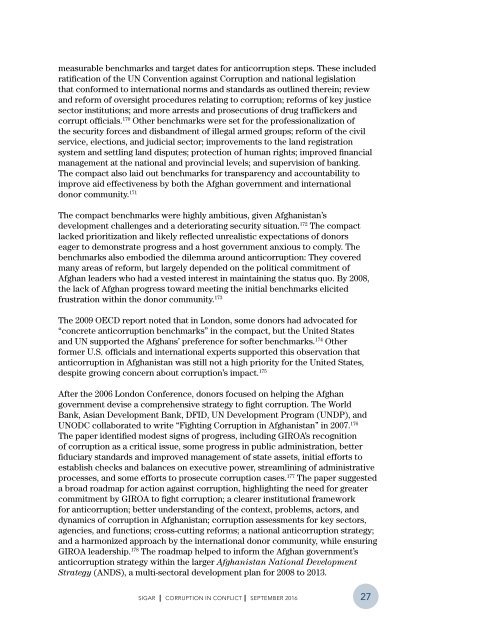CORRUPTION IN CONFLICT
5IlaWjQej
5IlaWjQej
Create successful ePaper yourself
Turn your PDF publications into a flip-book with our unique Google optimized e-Paper software.
measurable benchmarks and target dates for anticorruption steps. These included<br />
ratification of the UN Convention against Corruption and national legislation<br />
that conformed to international norms and standards as outlined therein; review<br />
and reform of oversight procedures relating to corruption; reforms of key justice<br />
sector institutions; and more arrests and prosecutions of drug traffickers and<br />
corrupt officials. 170 Other benchmarks were set for the professionalization of<br />
the security forces and disbandment of illegal armed groups; reform of the civil<br />
service, elections, and judicial sector; improvements to the land registration<br />
system and settling land disputes; protection of human rights; improved financial<br />
management at the national and provincial levels; and supervision of banking.<br />
The compact also laid out benchmarks for transparency and accountability to<br />
improve aid effectiveness by both the Afghan government and international<br />
donor community. 171<br />
The compact benchmarks were highly ambitious, given Afghanistan’s<br />
development challenges and a deteriorating security situation. 172 The compact<br />
lacked prioritization and likely reflected unrealistic expectations of donors<br />
eager to demonstrate progress and a host government anxious to comply. The<br />
benchmarks also embodied the dilemma around anticorruption: They covered<br />
many areas of reform, but largely depended on the political commitment of<br />
Afghan leaders who had a vested interest in maintaining the status quo. By 2008,<br />
the lack of Afghan progress toward meeting the initial benchmarks elicited<br />
frustration within the donor community. 173<br />
The 2009 OECD report noted that in London, some donors had advocated for<br />
“concrete anticorruption benchmarks” in the compact, but the United States<br />
and UN supported the Afghans’ preference for softer benchmarks. 174 Other<br />
former U.S. officials and international experts supported this observation that<br />
anticorruption in Afghanistan was still not a high priority for the United States,<br />
despite growing concern about corruption’s impact. 175<br />
After the 2006 London Conference, donors focused on helping the Afghan<br />
government devise a comprehensive strategy to fight corruption. The World<br />
Bank, Asian Development Bank, DFID, UN Development Program (UNDP), and<br />
UNODC collaborated to write “Fighting Corruption in Afghanistan” in 2007. 176<br />
The paper identified modest signs of progress, including GIROA’s recognition<br />
of corruption as a critical issue, some progress in public administration, better<br />
fiduciary standards and improved management of state assets, initial efforts to<br />
establish checks and balances on executive power, streamlining of administrative<br />
processes, and some efforts to prosecute corruption cases. 177 The paper suggested<br />
a broad roadmap for action against corruption, highlighting the need for greater<br />
commitment by GIROA to fight corruption; a clearer institutional framework<br />
for anticorruption; better understanding of the context, problems, actors, and<br />
dynamics of corruption in Afghanistan; corruption assessments for key sectors,<br />
agencies, and functions; cross-cutting reforms; a national anticorruption strategy;<br />
and a harmonized approach by the international donor community, while ensuring<br />
GIROA leadership. 178 The roadmap helped to inform the Afghan government’s<br />
anticorruption strategy within the larger Afghanistan National Development<br />
Strategy (ANDS), a multi-sectoral development plan for 2008 to 2013.<br />
SIGAR I <strong>CORRUPTION</strong> <strong>IN</strong> <strong>CONFLICT</strong> I SEPTEMBER 2016<br />
27


